Known as ‘The Vacation State’ and sometimes ‘The Pine Tree State’, Maine is home to famous author Stephen King as well as a number of head-turning Avian species. Who could blame them? With beautiful pine and other forests, islands, and more than 3000 miles of rocky coastlines, Maine has got a little something for many different types of birds. Today we are going to talk about some of those birds and give the inside scoop about where they like to roost, what they like to eat, and more. So stick with us and let’s talk about the popular backyard birds of Maine!
3 Categories – 292 Birds
With approximately 292 species of bird frequenting the state we don’t have anywhere near the space to cover all of them. With this in mind, we’ll simply divide them up by season and give you a sampling of 5 for each. The divisions will be as follows:
- Year-round Resident birds
- Birds of Spring, Summer, and Early Fall
- Fall and Winter Birds
By dividing up the birds in this manner you can quickly glance at the current season and get a few to look for or simply make yourself a year-round list that you can check off as you catch these winged wonders with some planning and the occasional lucky glimpse. We can’t guarantee that our tips will lure them in every time because, as you know, many of these birds are shy. That said, we’ll do our best to give you information that can greatly hedge your bets. Let’s get started with our feathered stars!
Maine’s Year-round Resident birds
Some birds have fallen in love with Maine and as a result, they spend all of their time here. They raise families, find favorite feeding spots, and have a grand old time in the Vacation state. See if you can spot any of these winged celebrities at any time this year:
- Black-capped Chickadee
- Downy Woodpecker
- Mourning Dove
- American Goldfinch
- Golden-crowned Kinglet
Black-capped Chickadee – Poecile atricapillus
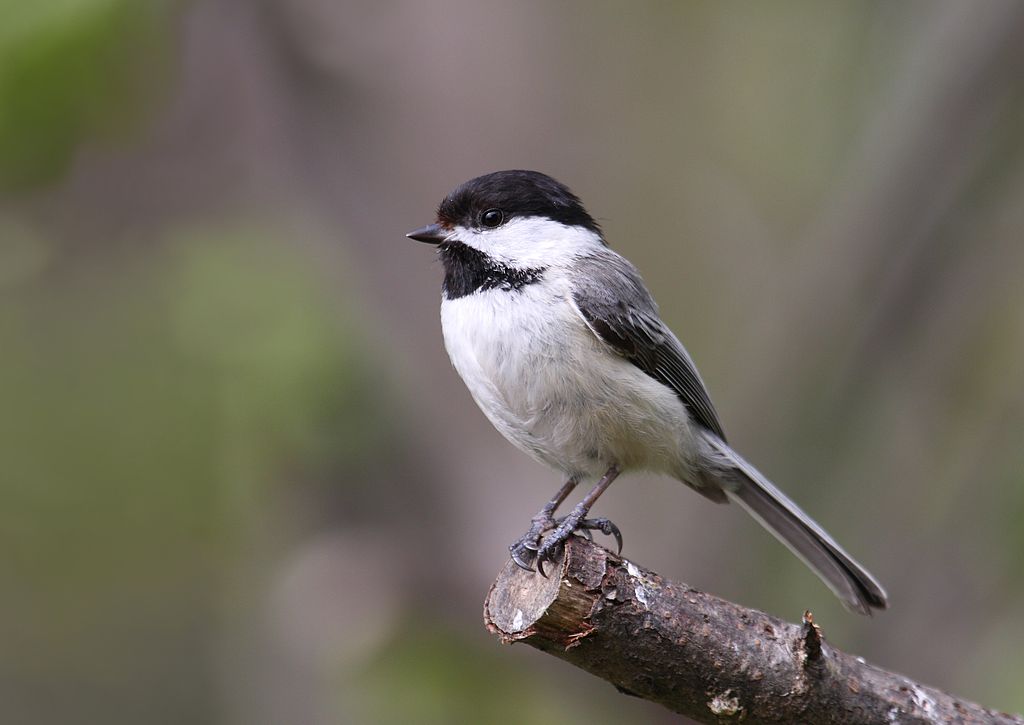
Coloration and Markings: The State Bird of Maine, has very distinctive plumage, making it easy to identify. These birds have gray backs, with short gray wings and long gray tails. There are some white accents in the wings and tail and the breast and underbelly of this bird are snowy-white. The face of this bird is white as well, but with a small, black bib and a large black cap, which goes from the top of the head to about the center of the eyes. This bird has a tiny, conical black bill.
Size: These birds measure in at 4.7 – 5.9 inches in length with wingspans of 6.3 to 8.3 inches.
Habitat: Trees and bushes are all that this bird needs to feed comfortable, although you can sometimes even find them in overgrown fields. They prefer parks and backyards with a touch of dense vegetation to give them a little cover.
Diet: The Black-capped Chickadee loves peanuts, suet, and Black Oil Sunflower seeds so if you have them be sure to set out a feast for your new feathered friend.
Downy Woodpecker – Picoides pubescens
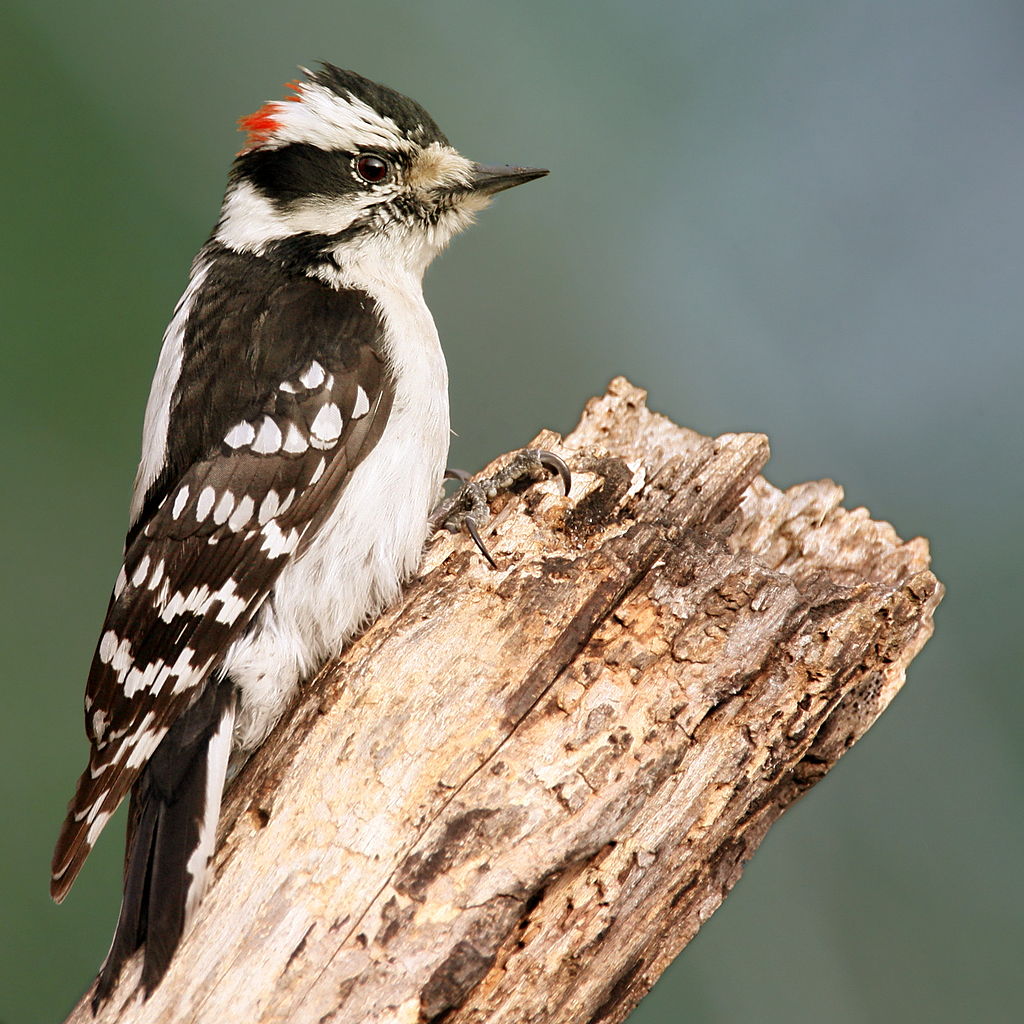
Coloration and Markings: Interestingly enough, these little Woodpeckers are sometimes seen with the Chickadees which we’ve just mentioned. Downy Woodpeckers have white back with black wings which sport a collection of stripes below the shoulder level, made of blocky white spots. This produces a bit of a ‘checkerboard’ effect that is quite pleasing. Their short tails show a visible separation in the center and are black on top and white underneath. The breast and underbelly of this bird are paper-white and this coloration continues upward to the face. While the face is mostly white, you will notice a black mustache mark coming from the bill and curving down to the base of the throat as well as a ‘bandit’ mask band and a thin black cap at the top. In males, there will be a red spot at the termination of the cap on the back of the bird’s head that you won’t see on females. This bird has a thin, medium-sized black bill.
Size: This bird measures in at 5.5 – 6.7 inches in length with a wingspan of 9.8 to 11 inches.
Habitat: These birds love open areas, such as meadows, knolls, and even weedy fields. Typically if there are a few trees and a little cover then this bird feels comfortable. They will happily visit a well-stocked feeder.
Diet: These birds like millet and Black Oil Sunflower seeds but they also have a sweet tooth. If you set up a Hummingbird feeder then they might sample the sugar water and they also have a weakness for chunky peanut butter.
Mourning Dove – Zenaida macroura
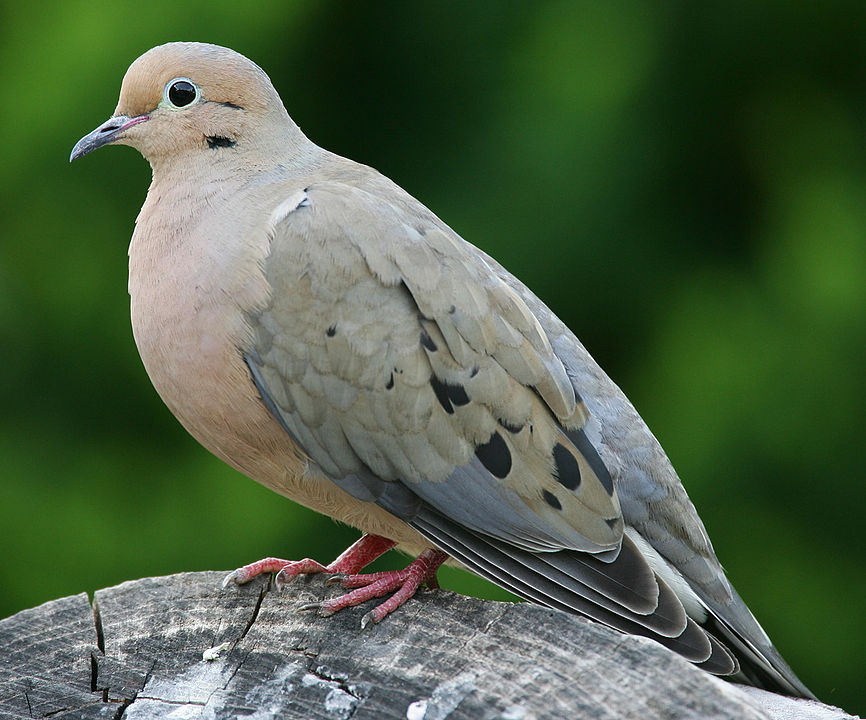
Coloration and Markings: Mourning Doves have soft gray back, wings, and long gray tails. The wings have a heavy saturation of creamy tan color and some distinctive large, black spots on the center of the folded wings. Their breast and underbelly are a lighter mix of white and tan, with more gray towards the underbelly. Facially, this bird has the deepest saturation of tan and this helps to highlight the white eyering that further confirms the identification. This bird has a medium-length, thin black bill.
Size: This bird measures in at 9.1 – 13.4 inches in length with a wingspan of approximately 17.7 inches.
Habitat: These birds became city birds long ago, giving up the deep woods for parks, sidewalks, phone lines, and backyards with feeders to welcome them. You might see one at the forest’s edge but more likely than not they are strolling around the city, just like you.
Diet: You can potentially lure a Mourning Dove to your feeder with peanuts, millet, Black Oil Sunflower seeds, or cracked corn. These Doves are easy to please.
American Goldfinch – Spinus tristis

Coloration and Markings: American Goldfinches are easy to recognize once you’ve seen one for the first time. They have bright yellow backs and black wings, with a single white wingbar as well as some white highlight on the shoulder, vertical white lines on the lower wing, and assorted white markings on the medium-length black tail, which is white on the underside. The breast and underbelly of this bird are also bright yellow, with white beginning at the rump, and facially this bird is yellow with a black cap beginning at the center of the top of the head which terminates at the short, conical orange bill. It almost looks as if the little guy has a black toupee so look for the distinctive cap and they are easy to identify. Females will be olive in color on their upper bodies but still have some muted yellow on the breast and underbelly and in winter these birds will simply be brown, but you can still spot them by their dimmed wingbars.
Size: These little guys measure in at 4.3 – 5.1 inches from tip to tail and have wingspans of 7.5 to 8.7 inches.
Habitat: In the wild these birds tend to prefer open areas with a bit of weedy cover so that they may forage in relative safety. They like areas which are prone to flooding as well as large, weedy field, both of which provide excellent foraging opportunities. They also range out into parks, gardens, orchards, and backyards. Leave a little something out for them and they might very well pay you a visit.
Diet: These birds love seeds so tempting them is as easy as loading your feeder with some Nyjer thistle and some small shelled or hulled Black Oil Sunflower seeds.
Golden-crowned Kinglet – Regulus satrapa
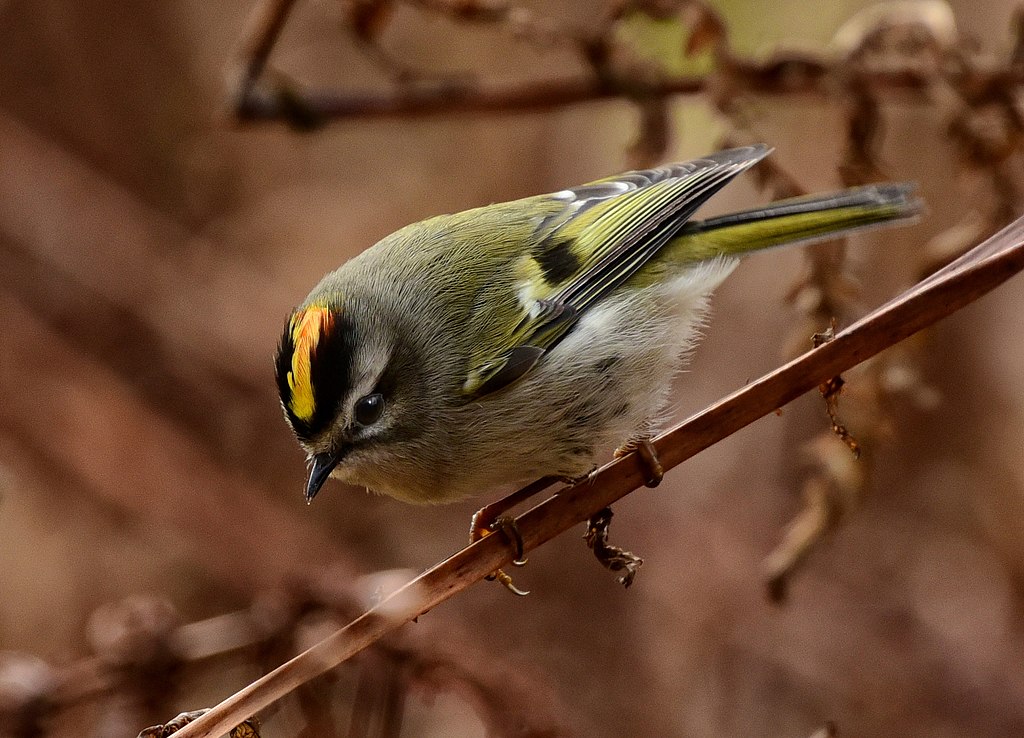
Coloration and Markings: Golden-crowned Kinglets are beautiful little birds. They have soft gray backs with olive green (or sometimes greenish yellow) wings and short gray and yellow/green tails. They have a thin white wingbar on each wing, often ‘underlined’ with black, and their breast and underbelly are a ‘dirty white’ mix of white and gray. Facially, these birds have a small black mustache mark and a vibrant yellow crown-crest on top of their gray head and the crown has a distinctive black underlining on it as well that you can’t miss. These birds have tiny, conical black bills.
Size: These tiny little songbirds are only 3.1 – 4.3 inches long and have wingspans of 5.5 to 7.1 inches from wingtip to wingtip.
Habitat: These birds may be found in boreal, coniferous, or montane woods but coniferous are their favorites. When they aren’t haunting a favorite Fir tree or Spruce they do like to range out and you can find them in parks, scrub, swamps, or backyards with feeders that have been stocked to lure them in. This is especially true in winter but they can visit at anytime, so be prepared.
Diet: While they eat mostly insects, you can sometimes lure them to your feeder with some small Black Oil Sunflower seeds, Nyjer thistle, and suet.
Maine’s Birds of Spring, Summer, and Early Fall
Maine residents know that the first sign of spring is most commonly the emergence and song of the beloved Bluebird. Things get green and colorful quickly and a number of new residents come flying in to stay until summer or plumb through to fall. See if you can spot some of these birds during this time:
- Black-throated Green Warbler
- Cedar Waxwing
- Red-eyed Vireo
- Chipping Sparrow
- Pine Grosbeak
Black-throated Green Warbler – Setophaga virens

Coloration and Markings: The Black Throated Green Warbler is a looker. They have gray backs and wings of gray with two distinctive wingbars, separated with black, and black highlights throughout the wings. Their tails are medium-length gray with some white on the sides and the breast is white with black flanking at the shoulders. The underbelly is white with some small black lines or streaks at the flanks and facially, this bird has a striking yellow face with an enormous black bib which carries down onto the breast. It rather looks like a large beard. You will also notice a brownish eyeline that bisects before the eye, with one line crossing it and another branching down to the cheek and a curved brownish line or two coming from the bill and carrying across face, curving, and just beneath the top of the head. Females and juveniles will have the same markings but will have muted coloration and will be lacking the enormous ‘beard’ seen on the males. These birds have thing, medium-length straight bills.
Size: These birds measure in at 4.3 – 4.7 inches in length with wingspans of 6.7 to 9 inches.
Habitat: Black Throated GreenWarblers prefer coniferous and deciduous forests, in that order, although they may be found just about anywhere that you find large, mature trees. They are comfortable in swamps as well though with less frequency.
Diet: These birds almost never visit feeders but may come to the backyard if you have some mature trees there. If you want to try to tempt them anyway, they do enjoy seeds and berries, so you could try Black Oil Sunflower, Nyjer thistle, and some chopped cherries or strawberries. No promises, though, as these birds are very shy.
Cedar Waxwing – Bombycilla cedrorum
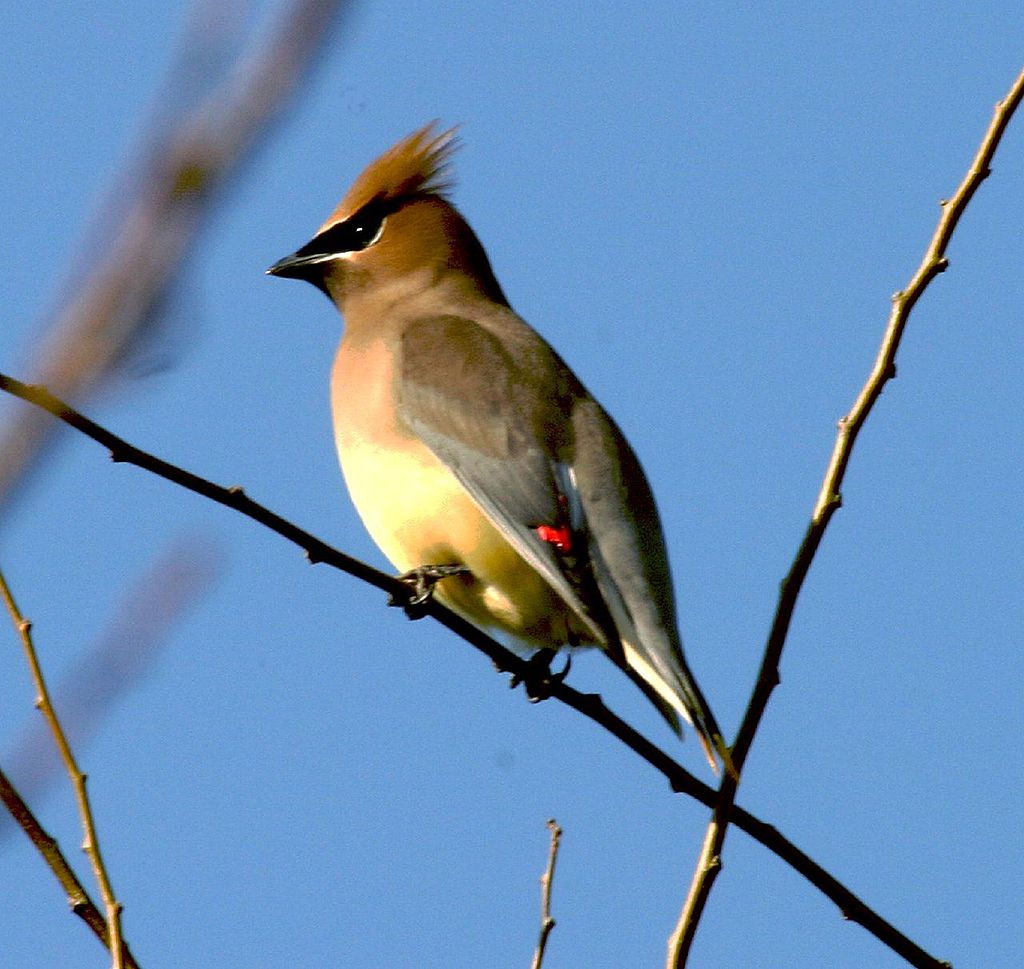
Coloration and Markings: The Cedar Waxwing has quite the elegant coloration. They have a smooth, darker brown on their back and shoulders while their wings are a soft gray, with white on the inner-edge of the folded wing just above a small, waxy-red wingbar type mark that is sometimes difficult to spot. Beneath the red mark there is dark gray to black as the color approaches the wingtips and these birds have tiny tails with bright yellow tips. The breast of this bird is a creamy tan while the underbelly is a mix of white and light yellow, while the rump tends to be completely white. Facially, this bird is reminiscent of a female cardinal, with velvety-rich light brown color to the face, a magnificent crest, and a mask that crosses the eyes and then heads up the face to terminate at the top-center of the head. White underlines the mask lightly and the bird has a black ‘goatee’ just under the small, slightly curved bill. This bird is beautiful and a prized sighting which you will definitely remember.
Size: These birds are 5.5 – 6.7 inches from head to tail and have wingspans of 8.7 to 11.8 inches.
Habitat: These birds are at home in forests of any type but they also like to range for more productive foraging. They are frequent visitors to orchards, gardens, parks, and backyard feeders
Diet: These birds are addicted to fruit and if you are growing any fruiting shrubs or trees then this will increase your chances of a visit. You can also add dried or preferably fresh fruit to your feeder with good results.
Red-eyed Vireo – Vireo olivaceus
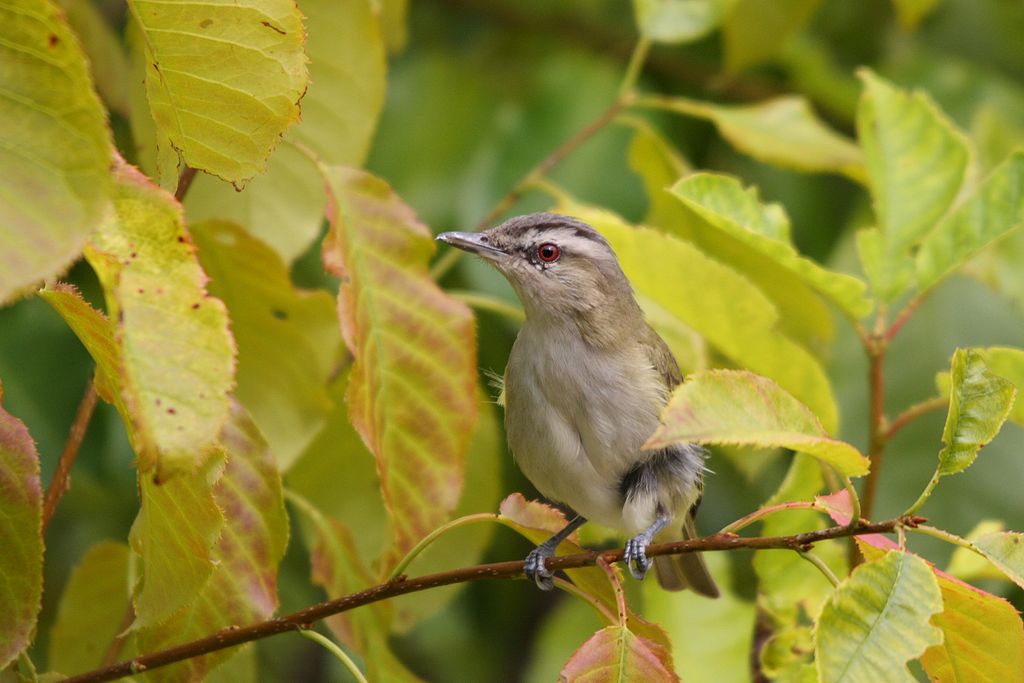
Coloration and Markings: Red-eyed Vireos are lovely little creatures. They have olive green backs and long, gray wings with olive coloration always present on the wing, either on the lower portion or throughout. Sometimes this is accented with black lines and they have short, gray and olive tails which are also olive green on the undersides. The breast and underbelly of this bird is white which gets a light addition of gray as it approaches the underbelly and a light splash of yellow green will be present underneath the wings. Facially, these birds are olive colored with a few exceptions. They will have a silver cap with a black eyebrow line that slants up, as if the bird is cross. They will have a white chin and a thin olive eyeline which goes to the back of the head. A small amount of white will be above and below this eyeline with the rest of the face being olive yellow-green. These birds have small, straight bills which are often black above and gray below. Only the adults will have red eyes.
Size: These birds measure in at 4.7 – 5.1 inches in length with wingspans of 9.1 to 9.8 inches.
Habitat: These birds love deciduous forests but may be found just about anywhere that the trees are stout and large-leaved. They sometimes visit parks and backyards as well and if you happen to have some trees in your backyard then your odds of a visit definitely go up.
Diet: These birds love bugs and berries, so try adding dried crickets or mealworms to your feeder with a dessert-side of dried or fresh berries.
Chipping Sparrow – Spizella passerina
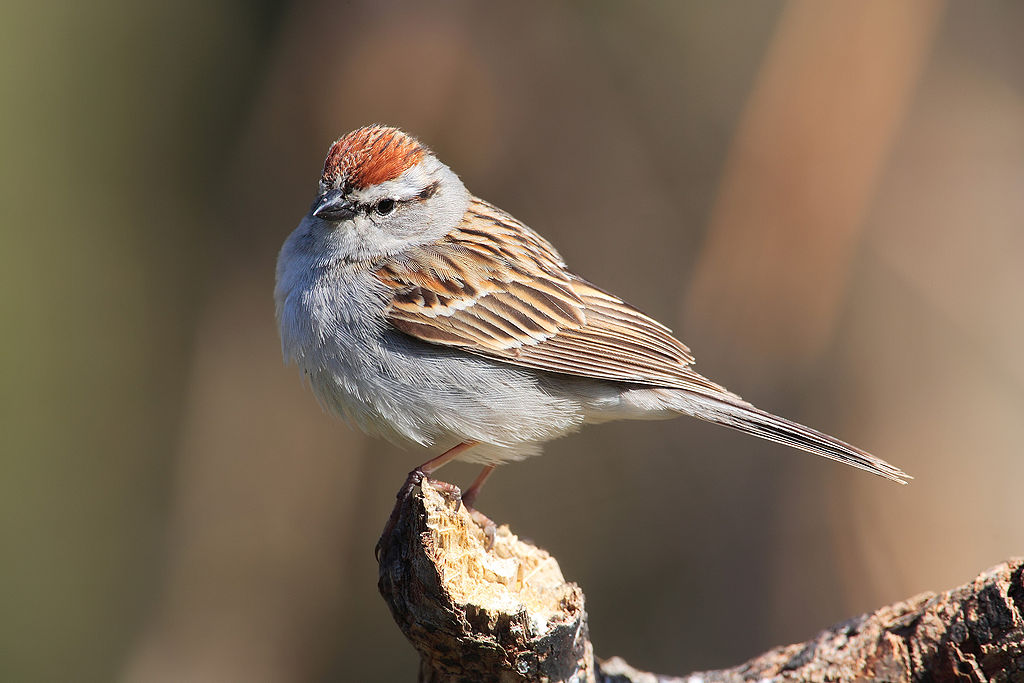
Coloration and Markings: Chipping sparrows have grayish-brown backs and wings which are brown and tan with dark streaking and thin, vertical dark lines accenting the wings. Some minor white edging is also present on the wings and these birds have medium-length gray tails with some minute black edging. The breast and underbelly of this bird are a ‘dirty snow’ gray and facially, this bird has a gray face with a white mustache line with a very small white line next to it, under the bill, and a distinctive thin, black eyeline which terminates at the back of the head. This bird has a rusty-red crown with some black in the front as it terminates at the small, conical black bill. In winter these birds molt and emerge as brown, but you can still spot the eyeline and crown to quickly identify them.
Size: These birds measure in at 4.7 – 5.9 inches in length and have wingspans of approximately 8.3 inches.
Habitat: These birds spend their time closer to the ground than most birds, preferring perches on fences or small trees and doing their foraging on the ground. They like the cover of high weeds, brambles, bushes, and thorns so if you have a bit of dense vegetation present in your backyard then this is a bonus when it comes to attracting Chipping Sparrows.
Diet: These birds are primarily insectivorous but they do supplement their diet with grains and fruits. Try adding some White Proso millet and chopped apples or cherries to your feeder and you might just tempt this bird’s tummy.
Pine Grosbeak – Pinicola enucleator

Coloration and Markings: Male Pine Grobeaks have rich red to reddish-pin backs, with long, gray wings with a few white highlights and two distinct wingbars. They have long, gray tails though red will be present at the rump and they have a red breast as well. The underbelly is gray but the red coloration of the breast continues upward to the bird’s face, where it is reddish-pink except for some gray around the eyes. They has short, stout black bills. Female Pine Grosbeaks tend to have more overall gray with some orangish-red present on the face and the rump.
Size: Roughly Robin-sized, these birds measure in at 7.9 – 9.8 inches from head to tail and have approximate wingspans of 13 inches in length.
Habitat: These birds love the forest the most in its open areas, such as copses and meadows. They favor trees such as Ash, Spruce, Fir, and Maple. They also visit parks and the occasional backyard, so be on the lookout!
Diet: The easiest and most effective lure for a Pine Grosbeak is going to be Black Oil Sunflower seeds, either shelled or hulled.
Maine’s Fall and Winter Birds
Maine winters make Frosty the Snowman happy, with lows approaching 12 degrees Fahrenheit. Certain hardy birds, however, are undaunted by this cold and might even be spotted snacking on the famous snowman’s head! Keep watch for these winter birds of Maine and see how many that you can spot:
- Dark-eyed Junco
- Tufted Titmouse
- Purple Finch
- Common Redpoll
- White-winged Crossbill
Dark-eyed Junco – Junco hyemalis

Coloration and Markings: Dark Eyed Juncos have simple, elegant coloration which makes them easy to identify. They have dark gray (sometimes brown) backs, wings, and long, gray tails with some white highlighting by means of white outer feathers. Their breast and underbelly have a dark gray flanking, thickest at the breast, while the center is a slightly shaded white. Facially, these birds have dark, gray heads and stout, conical ivory colored bills. When viewed at rest, 2/3 of this bird is gray and divided neatly with the bottom 3rd being the shaded white.
Size: These birds measure in at 5.5 – 6.3 inches in length with wingspans of 7.1 to 9.8 inches.
Habitat: Juncos prefer coniferous forests but may be found in any type. They are also fond of open areas such as weedy fields or woodlands and venture often to parks and backyard feeders.
Diet: These birds love cracked corn, White Proso millet, and Black Oil Sunflower seeds. Stock up on these and you might just make a new friend.
Tufted Titmouse – Baeolophus bicolor
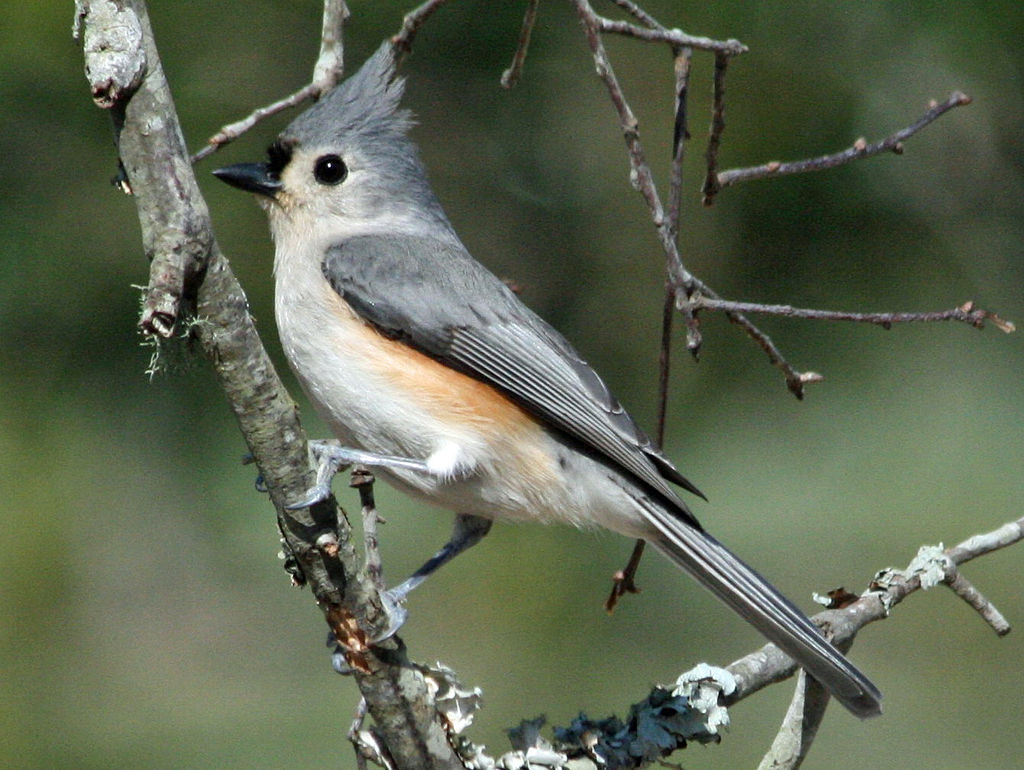
Coloration and Markings: Tufted Titmice have velvety gray backs, short gray wings, and long, gray tails with light undersides. They have a white breast and underbelly with a splash of peach on the flanks and the white of the breast carries up into the face. This bird’s face is white, with the exceptions of a soft blue crest where some blue coloration comes down the back of the neck and washes down to frame all but the bottom center of the eyes. This bird also has a distinctive black square above its short, curved black bill.
Size: These birds measure in at 5.5 – 6.3 inches in length with wingspans of 7.9 to 10.2 inches.
Habitat: These birds love Evergreen and deciduous woods, though they are frequent visitors to parks, orchards, and backyard feeders.
Diet: These birds have simple tastes, you can lure them in with some suet, peanuts, and a little Nyjer thistle mixed with Black Oil Sunflower seeds.
Purple Finch – Haemorhous purpureus
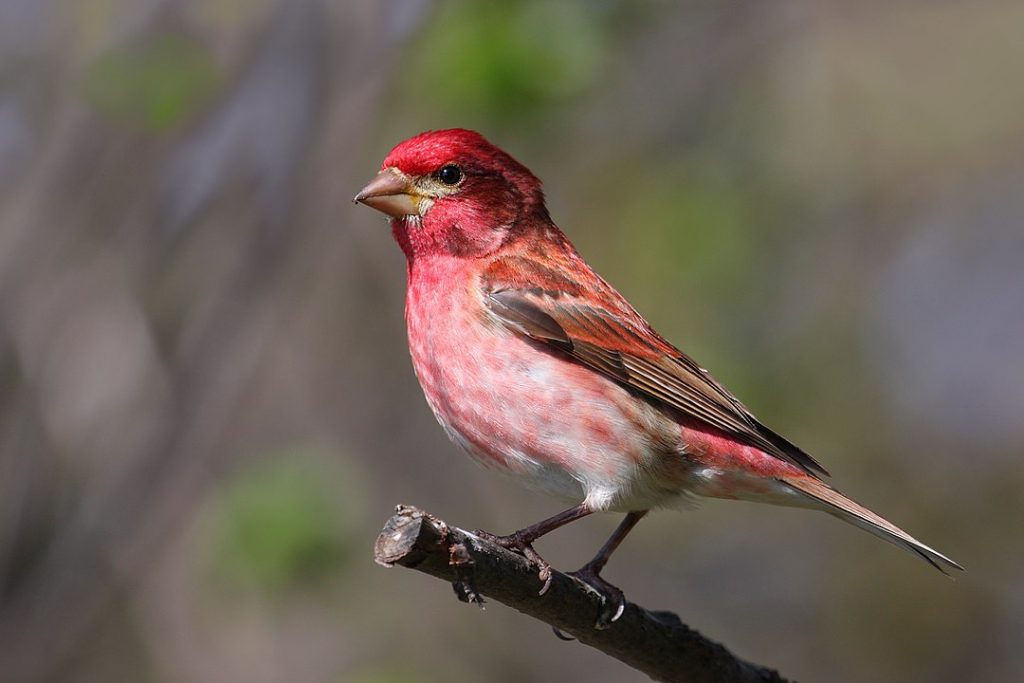
Coloration and Markings: Male Purple Finches look like they have taken a quick bath in grape juice. They have a raspberry purple coloration on their backs while their long, brown wings have splashes of raspberry and vertical brown-raspberry lines, with 2 thin white wingbars. Their tails are short and brown, light on the undersides, and their breast is white with a heavy saturation of the reddish-purple color which turns into fainter streaking patterns on the underbelly. The rump of this bird is white and facially, this bird has a light raspberry color with a dark, thick raspberry eyestripe that curls down and around to frame the cheek and often a dark raspberry line at the top of the head. These birds have short, straight and stout gray bills with black splotches often present on the top half of the bill and females are colored quite a bit differently. They don’t have any of the raspberry red but tend to be an olive-brown with heavy streaking and a white line above the eyes with a dark line at the throat.
Size: This bird measures in at 4.7 – 6.3 inches from tip to tail with a wingspan of 8.7 to 10.2 inches.
Habitat: These birds frequent coniferous and deciduous woods, with the former being their preference. They can also be found anywhere there is dense vegetation in the form of shrubs, brambles, or bushes. These birds might visit your backyard if the feeder is stocked but if there is some shrubby cover then this will increase your chances.
Diet: The best and simplest option for luring in a Purple Finch is Black Oil Sunflower seeds. They love them and most birders already have them on hand so set some out and watch the fun!
Common Redpoll – Acanthis flammea
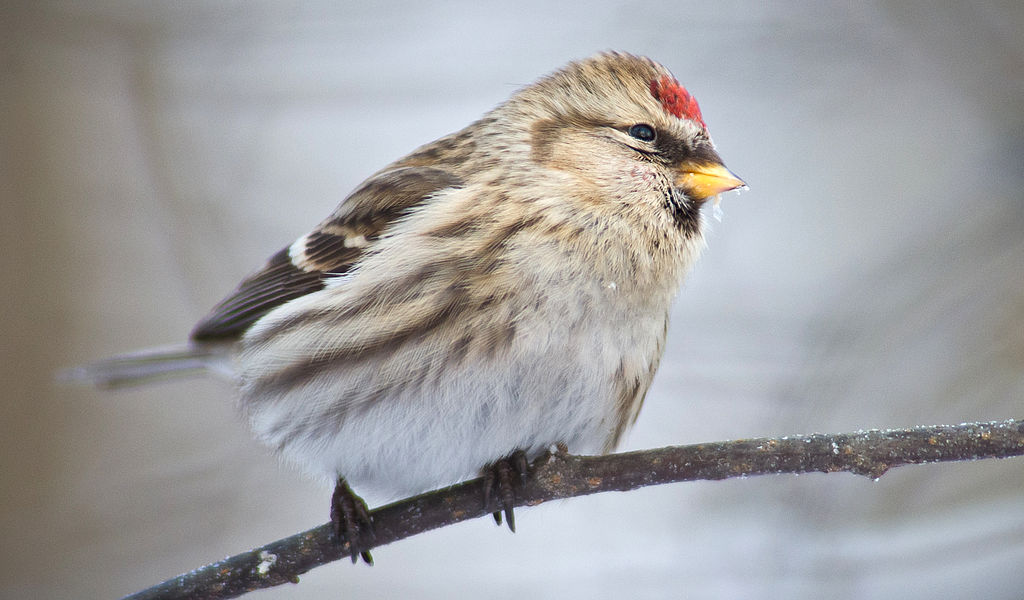
Coloration and Markings: Common Redpolls are easy to identify once you have seen one. They have gray and white backs with the gray displaying as a heavy streaking and the streaking continues on the long wings, which have two white wingbars to balance out the chaotic patterns. They have short, fanning gray tails with white edging and the breast is gray streaked white, with pure white flanking that extends just a little past the wingbars where the streaking starts again. The upper portion of the breast will have some raspberry coloration while the underbelly has faint streaking resolving into gray smudging on a white underbelly. Facially, the raspberry coloration from the breast extend up until under the bill, creating a raspberry bib and the remainder of the face is white with gray streaks, a small easy-to-miss eyebrow line, and a small red cap at the forehead. This bird has a tiny, straight yellow bill with a touch of dark gray on top.
Size: These birds measure in at 4.7 – 5.5 inches in length with wingspans of 7.5 to 8.7 inches.
Habitat: These birds prefer open wooded areas, especially coniferous and they are known to favor Willow trees. They also like overgrown fields and the safety of shrubs and like to visit backyard feeders most commonly in the winter.
Diet: A mix of Nyjer thistle and Black Oil Sunflower seeds is all that you need in order to tempt the Common Redpoll for a visit to your feeder. Easy-peasey!
White-winged Crossbill – Loxia leucoptera

Coloration and Markings: Male White Winged Crossbills have exemplary plumage. They have rosy-pink backs with long, black wings which bear 2 white wingbars and white lines towards the center for accent. They have medium-length, rounded, and somewhat split tails with rosy-pink breast and streaked gray underbellies. Facially, they are rosy red with the exception of a vertical dark line around the cheek and sometimes faint fragments of an eyeline. They have large, short slightly curved silver bills and females will have the same markings but their coloration is yellowish and gray. Juveniles, on the other hand, will be brown and streaked but still have the distinctive wingbars and silvery bills to help you recognize them.
Size: These birds measure in at 5.9 – 6.7 inches in length with wingspans averaging 10.2 to 11 inches.
Habitat: Boreal forests and weedy fields are where this bird likes to spend its time. They do occasionally visit parks and backyards, however, especially in winter when the pickings get a little lean.
Diet: These birds mostly eat conifer seeds but they can occasionally be tempted to make due with Black Oil Sunflower seeds. Try adding some Blueberries or Blackberries to your feeder as well as they sometimes supplement their diets with fruits.
Supporting cast (Other Backyard Birds of Maine that might pay you a visit)
While they didn’t get the ‘front page’ of this article, our ‘Supporting Cast’ of birds has a lot to offer and they are there for you throughout the year. See if you can’t spot some of these secondary celebrities while you are out for a walk or enjoying a cool drink on the porch:
- American Crow
- American Robin
- Northern Cardinal
- White-breasted Nuthatch
- Blue Jay
American Crow – Corvus brachyrhynchos

Coloration and Markings: American Crows are easy to identify, being black all over with the occasional gray when they are molting and they have long, slightly curved thick bills. Though common, American Crows are incredibly fun to watch. These feathered problem-solvers have a way of getting into places you’ve locked and have even been known to make tools, such as hooks for fishing food out of bottles. Sometimes they will even bring you shiny gifts, so give a little love to the American Crow.
Size: These birds measure 15.8 – 20.9 inches in length with wingspans of 33.5 to 39.4 inches.
Habitat: These birds love open areas, preferring meadows and copses in the woods and sometimes venturing into open, weedy fields for some practical foraging. They spend less and less time in the wild, however, opting instead for the easy pickings of the city where they raid dumpsters, waddle on the sidewalks, or perch on fences and phone lines as they scout for their next meal.
Diet: These birds love everything. They’ll fish out hamburger bits from dumpsters or wrangle some fruit from a tree. You can add items like peanuts, fruits, or even dog food to feeders if you wish to attract them. It is well worth your while with these clever birds!
American Robin – Turdus Migratorius
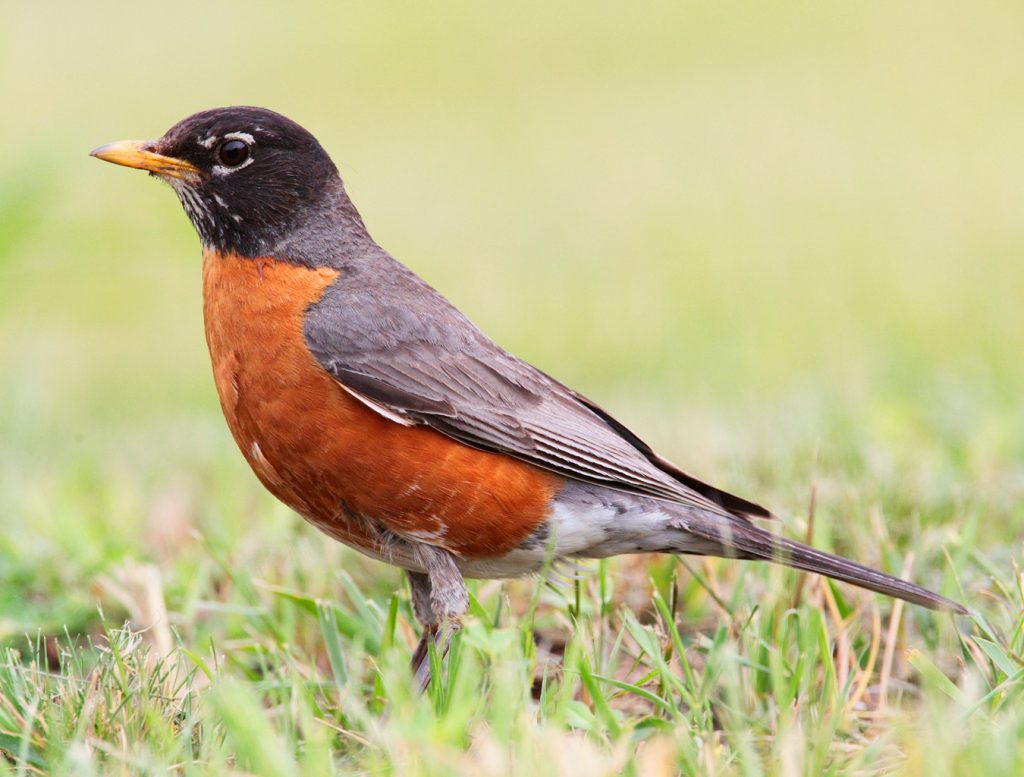
Coloration and Markings: American Robins have soft brownish-gray backs, long wings with some minute white highlighting, and long dark gray or brown tails with white undersides. They have and orange breast and underbelly with a white rump. Facially, these birds have black faces with distinct, fragmented white eyering marks and short, slightly curved yellow bills which are often lightly black-tipped.
Size: These birds measure in at 7.9 – 11 inches from head to tail with wingspans of 12.2 to 15.8 inches.
Habitat: American Robins are comfortable in many environs. You might see one playing in the snow or foraging in an overgrown field. They frequent parks and golf courses. You might find them deep in deciduous woods. They aren’t shy about people and will happily visit your feeder, provided that you have left them something which they like.
Diet: Chopped apples and mealworms are an easy combination that can attract these birds and keep them coming back for more. Give it a try and see for yourself!
Northern Cardinal – Cardinalis cardinalis
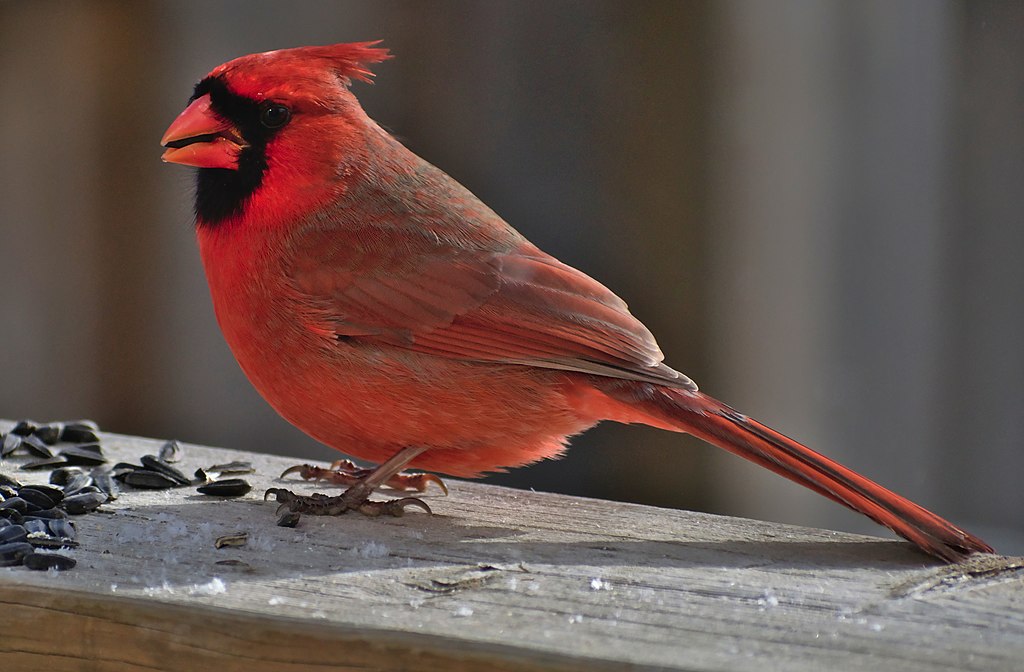
Coloration and Markings: Stunning birds, Northern Cardinals are completely red with some small exceptions. You will see the occasional gray in their plumage, most often when they are molting, and the red is broken on their face in the form of a distinct mask, which covers the eyes and moves down sharply to fill the chin in a distinct, angular way. These birds have beautiful, large crests and stout, conical yellow bills. Females are stunning in their own way, being brown with reddish tinges but no less eye-catching.
Size: These birds measure in at 8.3 – 9.1 inches in length with wingspans of 9.8 to 12.2 inches.
Habitat: Northern Cardinals like to spend time at the forest’s edge, provided that there is some shrubby, dense cover nearby. They are also quite fond of towns and cities, so it is not uncommon to see them on a phone line or fence looking for a tasty snack.
Diet: You can lure Cardinals with a simple fare of Black Oil Sunflower seeds but if you want to mix things up a bit, give them some crushed peanuts and cracked corn. Both you and the Cardinal will be pleased.
White-breasted Nuthatch – Sitta carolinensis

Coloration and Markings: White-breasted Nuthatches have velvety gray backs and short, gray wings with black highlights and a very thin white wingbar line. They have tiny, animated gray tails with black highlights and tips and which are white on the underside as well. The breast and underbelly of this bird are a bright white, though some mild gray enters the coloration towards the underbelly and a rust-red mark will sometimes be visibly present on the rump. Facially, these birds have white faces with a delicate gray around the eyes and cheek and a dim black eyeline arching upward from the back of the eye. These birds have a long, thin black cap at on their head which starts from the bill and goes to the back of the neck and they have medium-length, straight bills which are often black on the upper bill and silver on the lower.
Size: These birds measure in at 5.1 – 5.5 inches in length with wingspans of 7.9 to 10.6 inches.
Habitat: These birds prefer deciduous forests and their edges, being especially fond of such trees as Oak, Hickory, and Maple.
Diet: These birds will be very happy if you leave out some suet, Black Oil Sunflower seeds, and peanuts. This simple fare will produce delightful results once the bird knows that it is there.
Blue Jay – Cyanocitta cristata
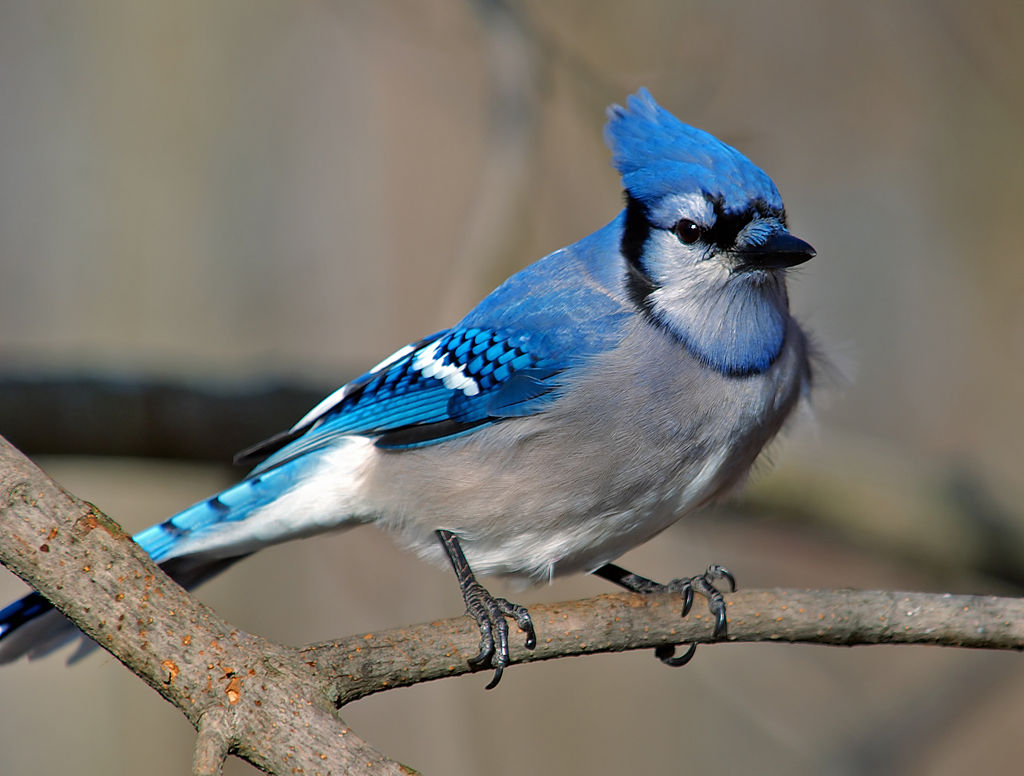
Coloration and Markings: Blue Jays are stunning. They have deep blue back and wings, with the wings exhibiting a white wingbar and white square spots outlined in black. Black scale patterns also decorate the wings and carry down to the medium-length blue tails where they manifest as lighter blue symmetrical squares outlined in darker blue. The undersides of the tail are white and so is the breast and underbelly. Facially, this bird has a beautiful blue crest with a black line trailing down and around the throat while the rest of the face is snowy white. The exception to this is a thin mask of zigzagging black and the long, straight black bill.
Size: These birds measure in at 9.8 – 11.8 inches in length with wingspans of 13.4 to 16.9 inches.
Habitat: Blue Jays love to frequent the forest’s edge, especially if there are Oaks nearby with delicious acorns that they can smash open and snack on. When they aren’t about the acorns, however, they are frequent visitors to parks and the city proper.
Diet: These birds love suet, Black Oil Sunflower seeds, and cracked corn so be sure to leave a little out. These are birds that you’ll never get tired of seeing.
Maine Bird Buffet
If you are looking to create a specialized feeder combination for attracting the most birds then you are in luck. We’ve got some advice of our own as well as some input from the University of Maine Cooperative Extension. In their article “Bird Feeding Basics” they have some great ideas so after you read the list if you’d like to see the full article just be sure to check our reference link below. We wish you the best on that perfect feeder! Be sure to include some or more of the following:
- Black Oil Sunflower
- White Proso millet
- Peanuts
- Cracked corn
- Peanut butter and suet mix (see reference link at the end of the article for instructions)
Maine Birding Hot Spots
If you wish to catch a glimpse of the feathered stars away from home or just happen to be visiting the lovely state of Maine then consider one of the following hotspots to spend a little time. You are sure to have some nice sightings and you might even snap some stunning photos like a proper Chirparazzo. We’ve selected locations close to central maine and to the furthest compass points but if you don’t find something that is close enough, don’t fret. Just check out our reference link below the list and you are sure to find the perfect place. Just don’t forget your binoculars because there are birds you won’t want to miss! See for yourself at one of these locations:
- Northern hotspot – Southern Bangor and Aroostook Trail
- Eastern hotspot – Sipayik Trail
- Southern hotspot – Fore River Parkway Trail
- Western hotspot – Norway Branch Rail Trail
- Central hotspot – Rotary Centennial Trail
Detailed descriptions of each location as well as information regarding visiting and what birds you can see at these locations may be found at https://www.traillink.com/stateactivity/me-birding-trails/
Some Closing Words
Today we have discussed birding in the Pine Tree State and we hope that you’ve heard a tip or two that you might not have had when you started reading. Birding in Maine is fun and rewarding and with so many locations to visit and so many birds willing to come to you, it’s a great place to be a birdwatcher. We wish you the best and don’t forget to clean and restock those feeders come spring. You’ve got guests arriving soon!
